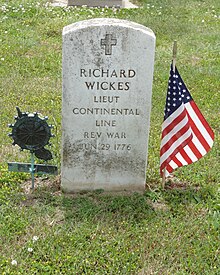Richard Wickes
Richard Wickes | |
|---|---|
 | |
| Born | unknown date Kent County, Maryland |
| Died | June 29, 1776 Turtle Gut Inlet near Cape May, New Jersey |
| Buried | |
| Allegiance | |
| Service | Continental Navy |
| Rank | Lieutenant |
| Battles / wars | American Revolutionary War |
Richard Wickes (died June 29, 1776) was an officer in the Continental Navy during the American Revolutionary War. He served as the third lieutenant on the Reprisal, captained by his brother Lambert Wickes.[1] During the Battle of Turtle Gut Inlet, he was the first American casualty of the war in New Jersey.[2][3]
Richard Wickes was born in Kent County, Maryland. His family home, Wickliffe, was on Eastern Neck Island.[4][5]
American Revolutionary War
Richard Wickes received his commission early in the war, as did his brother Lambert.[6] On March 28, 1776, they both began service on the newly commissioned 18-gun Reprisal. On June 10, the Committee of Secret Correspondence of Congress ordered Captain Wickes to set sail from Philadelphia, Pennsylvania and proceed to Martinique. On June 28, near Cape May, New Jersey, they joined forces with Captain John Barry on the Lexington to come to the aid of the privateer Nancy being chased by two British Navy ships, the 32-gun HMS Orpheus and the 16-gun HMS Kingfisher. Nancy was headed to Philadelphia with supplies loaded in the Caribbean islands of St. Thomas and St. Croix. The cargo contained several hundred kegs of gunpowder.[1][7]
Late on the afternoon of June 28, Captain Wickes ordered his brother Richard to lead an armed longboat to the Nancy and tell her captain, Hugh Montgomery, to head for the shore.[8] Lieutenant Wickes reached the Nancy soon after midnight. In the early hours of June 29, pursued by the British Orpheus and Kingfisher, the Nancy headed for the nearby Turtle Gut Inlet to run aground and salvage the cargo.[9] Lieutenant Wickes assisted in operations to return cannon fire and transfer the cargo ashore. By late in the morning of June 29, the British bombardment had heavily damaged the Nancy. Barry ordered the main sail wrapped around 50 pounds of gunpowder to create a long fuse running from the nearly 100 gunpowder kegs remaining in the hold to the deck and over the side. The fuse was lit as the crew abandoned ship. As the British boarded the ship, the fuse reached the hold. The gunpowder exploded with a huge blast felt for miles which killed many British.[9]
After the explosion, Lieutenant Wickes was killed by subsequent British cannon fire. He was the only American casualty.[9][10] Captain Wickes, in a letter to his brother Samuel, described how he had seen his brother die in the final four or five minutes of the battle. He was recognized for his bravery by both his brother and Captain Barry, who said that "a braver man never lived."[10][11]
Legacy
Lieutenant Richard Wickes is buried at the Cold Spring Presbyterian Church cemetery. A section of the cemetery, Veterans Field of Honor, is dedicated to his service "in the cause of American freedom."[12] There is a second memorial marker in Cape May, New Jersey.[13]
Gallery
- Cold Spring Presbyterian Church cemetery
-
Lieutenant Richard Wickes memorial
-
Veterans Field of Honor
- Cape May
-
Lieutenant Richard Wickes memorial
References
- ^ a b "Reprisal". Dictionary of American Naval Fighting Ships. Navy Department, Naval History and Heritage Command.
- ^ Johnson 2006, pp. 95–6
- ^ Lundin, Leonard (1940). Cockpit of the Revolution - The War for Independence in New Jersey. Princeton University Press. p. 113.
- ^ Clark 1932, p. 12
- ^ "American War of Independence - At Sea: Officers".
- ^ "Officers of the Continental Navy and Marine Corps". Naval History & Heritage Command.
- ^ Johnson 2006, pp. 94–5
- ^ Clark 1938, p. 96
- ^ a b c Johnson 2006, p. 95
- ^ a b Morgan 1970, pp. 882–884
- ^ Clark 1938, p. 98
- ^ "Revolutionary War Sites in Cape May, New Jersey". Revolutionary War New Jersey.
- ^ "Lt. Richard Wickes". Historical Marker Database.
Bibliography
- Clark, William Bell (1932). Lambert Wickes, Sea Raider and Diplomat: The Story of a Naval Captain of the Revolution. Yale University Press.
{{cite book}}: CS1 maint: ref duplicates default (link) - Clark, William Bell (1938). Gallant John Barry, 1745–1803: The Story of a Naval Hero of Two Wars (PDF). New York: The Macmillan Company.
{{cite book}}: CS1 maint: ref duplicates default (link) - Johnson, Robert Amandus (2006). Saint Croix 1770–1776: The First Salute to the Stars and Stripes. ISBN 9781425970086.
{{cite book}}: CS1 maint: ref duplicates default (link) - Morgan, William James, ed. (1970). Naval Documents of The American Revolution, American Theatre: May 9, 1776 – July 31, 1776 (PDF). Vol. 5. Washington, D.C.: Naval History Division/Naval Historical Center, Department of the Navy.
{{cite book}}: CS1 maint: ref duplicates default (link)
External links
- "Lt. Richard Wickes". Historical Marker Database.



